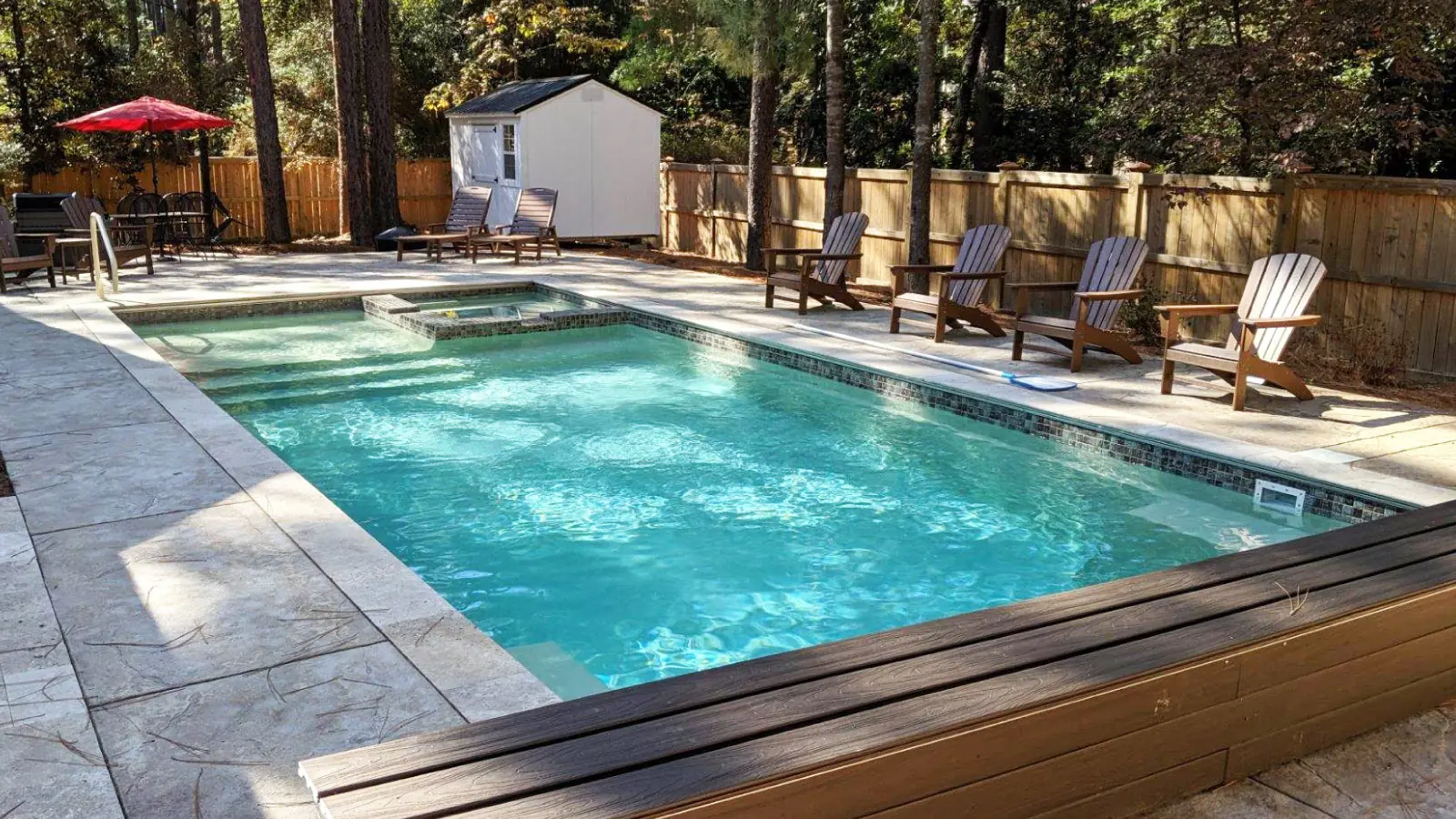
Pool Maintenance Made Easy
Introduction: Dive Into a Cleaner, Easier Pool Experience
Ever wonder why some pools always seem effortlessly pristine, while others feel like a constant battle against murky water and mysterious stains? Here’s a surprising statistic: according to the CDC, over 58% of public pool water samples contain contaminants due to poor pool maintenance. Now imagine what that could mean for your backyard oasis if upkeep isn’t a priority.
The truth is, a sparkling, stress-free pool isn’t a luxury—it’s the result of consistent, smart maintenance.
Picture this: it’s a warm summer afternoon. The sun dances across the surface of your pool, the water is crystal-clear, and you ease in, feeling the cool depths wrap around you. No algae. No cloudy water. Just pure relaxation.
Your pool is like a luxury automobile—it performs beautifully when cared for regularly, but even the most elegant design can break down without proper attention.
Many homeowners believe pool maintenance is time-consuming and complicated. But the reality? A simple, consistent routine can make it almost effortless.
In this guide, we’ll walk you through practical, manageable steps to simplify your pool maintenance routine—whether you’re a new pool owner or a seasoned swimmer. If you’re looking to master the art of pool maintenance without the stress, you’re in the right place.
#1. Why Pool Maintenance Matters
Benefits of Consistent Care
Routine pool maintenance is essential for safety, longevity, and enjoyment. Here’s why:
- Preserves water quality and ensures a safe swimming environment.
- Extends the life of pool equipment and surfaces.
- Prevents costly repairs and unexpected downtime.
- Keeps your backyard oasis looking inviting and well-kept year-round.
Common Consequences of Neglect
Skip regular upkeep, and problems can escalate quickly:
- Algae blooms, cloudy water, and unpleasant odors.
- Clogged filters and malfunctioning pumps.
- Bacterial contamination that can pose health risks.
Avoiding these issues starts with understanding your pool’s needs—and staying one step ahead. Backyard Pool Patio is a great place to explore more about caring for your pool year-round.
#2. Why Fiberglass Pools Are Low Maintenance
Advantages Over Other Pool Types
If low maintenance is a priority, fiberglass pools are a winning choice. Here’s why they stand out:
- Non-porous surfaces resist algae growth, reducing the need for scrubbing.
- Fewer chemicals are required to maintain proper water balance.
- Durable construction means less staining, cracking, or resurfacing over time.
Ideal for Busy Homeowners
Fiberglass pools are designed for simplicity and ease:
- Lower lifetime maintenance costs compared to concrete or vinyl pools.
- Quick cleaning routines and minimal chemical adjustments make upkeep a breeze.
For homeowners who want more time enjoying their pool and less time maintaining it, fiberglass is a smart, stress-free option.
#3. Daily Pool Maintenance Tips
Simple Tasks That Make a Big Difference
A few minutes each day can prevent bigger issues down the line. Add these quick tasks to your daily routine:
- Skim debris from the surface using a leaf net to prevent clogs and staining.
- Check water levels to ensure the skimmer functions properly.
- Inspect the pool area for safety hazards like loose tiles or slippery surfaces.
Quick Visual Checks
Make it a habit to observe your pool’s condition:
- Look for signs of algae, discoloration, or floating debris.
- Ensure the pump and filtration systems are operating efficiently.
These small steps help you catch problems early—before they become costly repairs.
#4. Weekly Swimming Pool Maintenance Routine
Water Chemistry Essentials
Testing and balancing your pool’s water chemistry is key to swimmer safety and water clarity. Each week, be sure to:
- Test pH, chlorine, and alkalinity levels using a reliable test kit.
- Adjust chemicals as needed to maintain proper balance.
Ideal ranges:
- pH: 7.2–7.4
- Chlorine: 1–3 ppm
- Alkalinity: 80–120 ppm
Cleaning and Circulation
A deeper clean once a week helps your pool sparkle:
- Brush the pool walls and floor to prevent algae and buildup.
- Vacuum debris using a manual or robotic cleaner.
- Empty skimmer and pump baskets to maintain optimal circulation.
Need help setting up a weekly plan? Reach out through our Contact Page for personalized support.
#5. Monthly Maintenance of Swimming Pool Systems
Deep Cleaning Tasks
Once a month, go beyond the basics to keep your systems running smoothly:
- Inspect and clean pool filters thoroughly.
- Backwash sand or DE filters to remove trapped debris and restore efficiency.
Equipment Check
Take time to inspect your pool equipment for signs of wear or malfunction:
- Examine the pump, heater, and chlorinator.
- Test for calcium hardness and cyanuric acid levels to ensure long-term water stability.
Record Keeping
Maintain a log of:
- Chemical readings
- Cleaning schedules
- Any repairs or equipment issues
This helps identify patterns and plan for future maintenance.
#6. Seasonal Pool Care Strategies
Every season brings new challenges—and opportunities—for pool care.
Spring
- Remove and store your winter cover properly.
- Inspect the pool structure and equipment.
- Balance water chemistry to start the season fresh.
Summer
- Increase filtration time to handle higher swimmer load and heat.
- Monitor chlorine levels closely, as UV rays can degrade sanitizer quickly.
Fall
- Skim leaves daily to prevent staining and clogging.
- Begin preparing for winterization by adjusting water chemistry and removing accessories.
Winter
- Lower the water level and add winterizing chemicals.
- Secure the cover tightly to keep out debris and algae.
A seasonal plan ensures your pool stays in top shape year-round.
#7. Troubleshooting Common Pool Problems
Cloudy Water
- Check your filtration system—clean or backwash as needed.
- Shock the pool to eliminate organic contaminants.
Algae Growth
- Brush all affected areas thoroughly.
- Apply an algaecide and ensure chlorine levels are maintained.
Stains
- Identify the type of stain: organic (leaves, algae) or metal (iron, copper).
- Use appropriate stain removers and prevent recurrence with regular brushing and water balance.
Addressing small issues early prevents them from becoming major headaches.
#8. Tools That Make Pool Maintenance Easier
Must-Have Equipment
Investing in the right tools transforms routine pool care:
- Robotic pool cleaner for hands-free, efficient vacuuming.
- Digital or liquid test kits for accurate chemical readings.
- Telescopic pole with interchangeable attachments (brush, skimmer, vacuum).
Nice-to-Have Extras
These additions can further streamline your routine:
- Floating chemical dispensers for consistent sanitizer levels.
- Automatic pool covers to reduce debris and evaporation.
Smart tools save time and effort—so you can spend more time enjoying your pool.
#9. Energy-Efficient Pool Maintenance Tips
Smart Equipment Choices
Energy efficiency isn’t just good for the environment—it’s good for your wallet:
- Upgrade to variable-speed pumps to reduce electricity use.
- Install solar-powered heaters or covers to harness natural energy.
Water and Chemical Conservation
Reduce waste and preserve resources with these simple strategies:
- Use a pool cover to minimize evaporation and chemical loss.
- Maintain balanced water chemistry to avoid unnecessary draining and refilling.
Small changes can lead to big savings over time.
#10. When to Call in the Pros
Signs You Need Professional Help
Sometimes, it’s best to leave it to the experts. Call in a pro if:
- Water chemistry won’t balance despite adjustments.
- You hear unusual noises or notice leaks from equipment.
- Persistent stains or algae resist treatment.
Benefits of Professional Services
Hiring a pool professional offers peace of mind:
- Expert analysis and fast troubleshooting.
- Customized maintenance plans tailored to your pool.
- Access to commercial-grade tools and treatments.
Professional service can be the difference between frustration and flawless function.
#11. Maintaining the Pool Surroundings
Keep the Deck Area Clean
A clean pool area enhances safety and aesthetics:
- Sweep regularly to remove leaves, dirt, and debris.
- Pressure wash surfaces to prevent mildew and staining.
Landscaping Considerations
Thoughtful landscaping reduces maintenance:
- Trim trees and shrubs to minimize falling debris.
- Avoid planting species that shed heavily near the pool.
Safety and Ambiance
Create a space that’s both safe and serene:
- Check lighting, fencing, and safety equipment regularly.
- Incorporate stylish, easy-to-clean decor to enhance the atmosphere.
A well-maintained pool area adds value and enjoyment to your outdoor space.
#12. Conclusion: Make Pool Maintenance a Breeze
Pool maintenance doesn’t have to be overwhelming. With a simple daily, weekly, and seasonal routine, you can enjoy a clean, safe, and beautiful pool all year long.
Whether you’re caring for a fiberglass pool or another type, consistent upkeep ensures that your backyard oasis remains a source of joy—not stress.
Ready to simplify your pool care routine? Contact the experts at Backyard Pool and Patio and take the next step toward effortless pool ownership.
By following this guide, you’ll not only extend the life of your pool but also enhance the quality of your outdoor living experience. Dive into maintenance with confidence—and enjoy every moment in your crystal-clear retreat.


